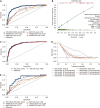MH-STRALP: A scoring system for prognostication in patients with upper gastrointestinal bleeding
- PMID: 38577095
- PMCID: PMC10989336
- DOI: 10.4240/wjgs.v16.i3.790
MH-STRALP: A scoring system for prognostication in patients with upper gastrointestinal bleeding
Abstract
Background: Upper gastrointestinal bleeding (UGIB) is a common medical emergency and early assessment of its outcomes is vital for treatment decisions.
Aim: To develop a new scoring system to predict its prognosis.
Methods: In this retrospective study, 692 patients with UGIB were enrolled from two centers and divided into a training (n = 591) and a validation cohort (n = 101). The clinical data were collected to develop new prognostic prediction models. The endpoint was compound outcome defined as (1) demand for emergency surgery or vascular intervention, (2) being transferred to the intensive care unit, or (3) death during hospitalization. The models' predictive ability was compared with previously established scores by receiver operating characteristic (ROC) curves.
Results: Totally 22.2% (131/591) patients in the training cohort and 22.8% (23/101) in the validation cohort presented poor outcomes. Based on the stepwise-forward Logistic regression analysis, eight predictors were integrated to determine a new post-endoscopic prognostic scoring system (MH-STRALP); a nomogram was determined to present the model. Compared with the previous scores (GBS, Rockall, ABC, AIMS65, and PNED score), MH-STRALP showed the best prognostic prediction ability with area under the ROC curves (AUROCs) of 0.899 and 0.826 in the training and validation cohorts, respectively. According to the calibration curve, decision curve analysis, and internal cross-validation, the nomogram showed good calibration ability and net clinical benefit in both cohorts. After removing the endoscopic indicators, the pre-endoscopic model (pre-MH-STRALP score) was conducted. Similarly, the pre-MH-STRALP score showed better predictive value (AUROCs of 0.868 and 0.767 in the training and validation cohorts, respectively) than the other pre-endoscopic scores.
Conclusion: The MH-STRALP score and pre-MH-STRALP score are simple, convenient, and accurate tools for prognosis prediction of UGIB, and may be applied for early decision on its management strategies.
Keywords: Nomogram; Post-endoscopic model; Pre-endoscopic model; Prognosis prediction; Retrospective study; Upper gastrointestinal bleeding.
©The Author(s) 2024. Published by Baishideng Publishing Group Inc. All rights reserved.
Conflict of interest statement
Conflict-of-interest statement: Dr. Zeng has nothing to disclose.
Figures




Similar articles
-
AIMS65, Glasgow-Blatchford bleeding score and modified Glasgow-Blatchford bleeding score in predicting outcomes of upper gastrointestinal bleeding: An accuracy and calibration study.Indian J Gastroenterol. 2023 Aug;42(4):496-504. doi: 10.1007/s12664-023-01387-z. Epub 2023 Jun 29. Indian J Gastroenterol. 2023. PMID: 37382854
-
Risk stratification in acute upper GI bleeding: comparison of the AIMS65 score with the Glasgow-Blatchford and Rockall scoring systems.Gastrointest Endosc. 2016 Jun;83(6):1151-60. doi: 10.1016/j.gie.2015.10.021. Epub 2015 Oct 26. Gastrointest Endosc. 2016. PMID: 26515955
-
Validation of a Machine Learning Model That Outperforms Clinical Risk Scoring Systems for Upper Gastrointestinal Bleeding.Gastroenterology. 2020 Jan;158(1):160-167. doi: 10.1053/j.gastro.2019.09.009. Epub 2019 Sep 25. Gastroenterology. 2020. PMID: 31562847 Free PMC article.
-
Comparison of risk scoring systems for patients presenting with upper gastrointestinal bleeding: international multicentre prospective study.BMJ. 2017 Jan 4;356:i6432. doi: 10.1136/bmj.i6432. BMJ. 2017. PMID: 28053181 Free PMC article.
-
Pre-Endoscopic Scores Predicting Low-Risk Patients with Upper Gastrointestinal Bleeding: A Systematic Review and Meta-Analysis.J Clin Med. 2023 Aug 9;12(16):5194. doi: 10.3390/jcm12165194. J Clin Med. 2023. PMID: 37629235 Free PMC article. Review.
References
-
- Kamboj AK, Hoversten P, Leggett CL. Upper Gastrointestinal Bleeding: Etiologies and Management. Mayo Clin Proc. 2019;94:697–703. - PubMed
-
- Rotondano G. Epidemiology and diagnosis of acute nonvariceal upper gastrointestinal bleeding. Gastroenterol Clin North Am. 2014;43:643–663. - PubMed
-
- Herrera JL. Management of acute variceal bleeding. Clin Liver Dis. 2014;18:347–357. - PubMed
-
- GBD 2017 Disease and Injury Incidence and Prevalence Collaborators. Global, regional, and national incidence, prevalence, and years lived with disability for 354 diseases and injuries for 195 countries and territories, 1990-2017: a systematic analysis for the Global Burden of Disease Study 2017. Lancet. 2018;392:1789–1858. - PMC - PubMed
LinkOut - more resources
Full Text Sources

